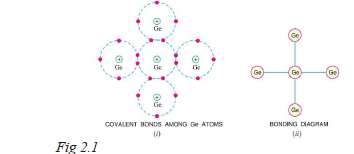- The atoms of every element are held together by the bonding action of valence electrons. This bonding is due to the fact that it is the tendency of each atom to complete its last orbit by acquiring 8 electrons in it. However, in most of the substances, the last orbit is incomplete i.e. the last orbit does not have 8 electrons. This makes the atom active to enter into bargain with other atoms to acquire 8 electrons in the last orbit. To do so, the atom may lose, gain or share valence electrons with other atoms.
- In semiconductors, bonds are formed by sharing of valence electrons. Such bonds are called covalent bonds. In the formation of a covalent bond, each atom contributes equal number of valence electrons and the contributed electrons are shared by the atoms engaged in the formation of the bond.
- Fig. 2.1 shows the covalent bonds among germanium atoms. A germanium atom has 4 valence electrons. It is the tendency of each germanium atom to have 8 electrons in the last orbit. To do so, each germanium atom positions itself between four other germanium atoms as shown in Fig. 2.1 (i). Each neighbouring atom shares one valence electron with the central atom.
- In this business of sharing, the central atom completes its last orbit by having 8 electrons revolving around the nucleus. In this way, the central atom sets up covalent bonds. Fig. 2.1 (ii) shows the bonding diagram.
- The following points may be noted regarding the covalent bonds :

(i) Covalent bonds are formed by sharing of valence electrons.
(ii) In the formation of covalent bond, each valence electron of an atom forms direct bond with the valence electron of an adjacent atom. In other words, valence electrons are associated with particular atoms. For this reason, valence electrons in a semiconductor are not free.
Wilfykil answered the question on
August 13, 2019 at 12:09